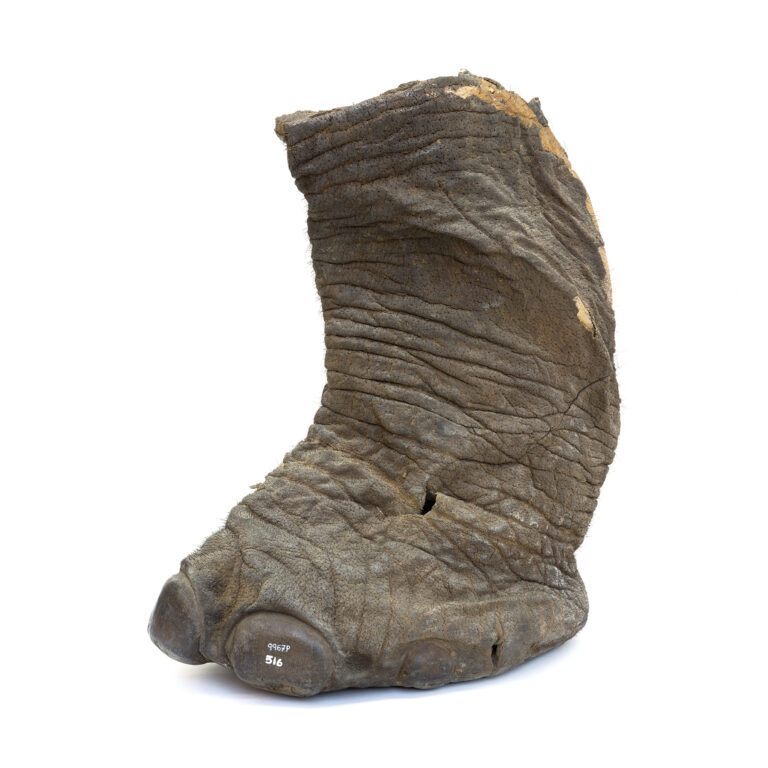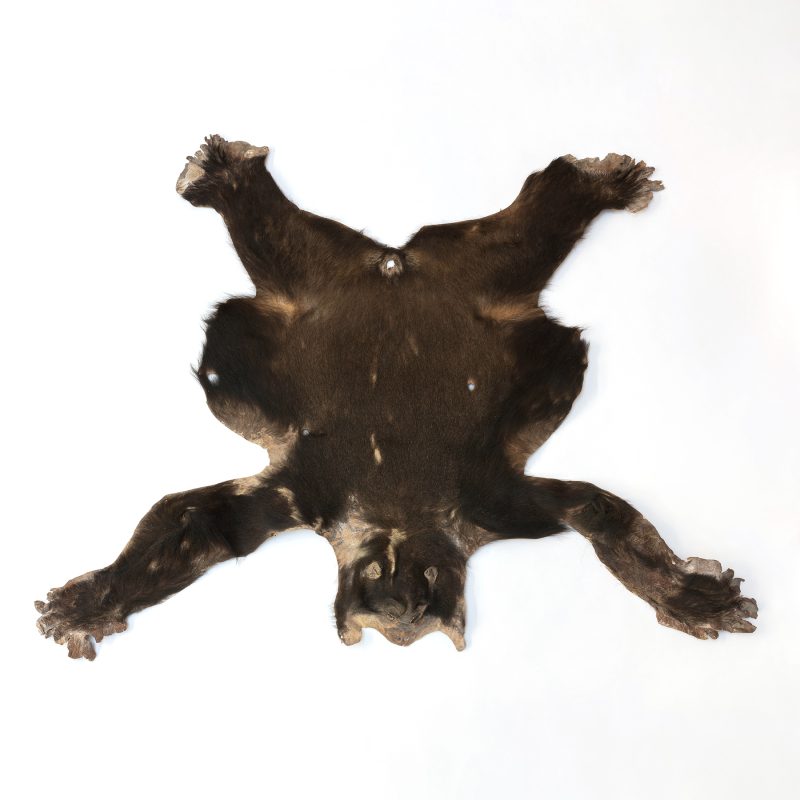Summary of results
The elephant’s foot belongs to the museum’s general collection and was tanned at the Igualada Tanning School. It is in average condition and is currently housed in the light storage room of the museum building. It arrived in 1957 and the inventories state that it was supposedly donated by Jordi Sabater Pi. Despite having a very small collection of colonial origin—twelve pieces of Guinean origin and twenty-one from Morocco—the Igualada Leather Museum had an active colonial section until the 1960s, promoted by the initiative of the primatologist Jordi Sabater Pi, a context that would explain the existence of this piece and others in the collection.
Apart from this information, there is no other record in the museum’s collection that would allow us to know its provenance, although there is information in secondary archives. For example, through correspondence we know of the close links between August Panyella, director of the Ethnological Museum, Antoni Jonch, director of the Zoo, the primatologist Jordi Sabater Pi, and the hunter Lluís de Lassaletta. The correspondence of the Igualada Leather Museum sends greetings to the Lassaletta through Sabater Pi, the former was the supplier of some pieces donated by the primatologist, a fact that allows us to link this piece possibly to the Bindung (Ikunde) Acclimatization Garden, located near the city of Bata. This deduction would also link to the legislation that limited elephant hunting in Guinea, due to the danger of extinction, in 1953, and where scientific activities were left aside and allowed the continued ecological exploitation of the colony.
Chronological reconstruction of provenance
The information provided by the museum indicates that the piece was acquired in 1957. However, thanks to the Jordi Sabater Pi collection at the University of Barcelona and his correspondence, we also know that it took longer than expected for the leg to enter the museum’s collection. On 30 June 1957, the president of the Board of Trustees—Joan Riba i Faura—and his secretary—F. de P. Gabarró—informed Sabater Pi, through the primatologist’s sister-in-law, that the elephant’s leg had not arrived. According to the same document, the sister-in-law claimed it from August Panyella, who we know was also an intermediary in this process as a regular collaborator of Jordi Sabater Pi in many colonial businesses in Guinea. In fact, the family of the latter’s wife, Nuria Coca Estadella, was from Igualada, and this link is key to understanding the relationship between Sabater Pi and the institution. We do not know how long it took for the elephant’s foot to arrive and the reasons for the delay, but we are certain that the tanning process was carried out at the Igualada Tanning School (usually by a Mr. Vilarrubies, who followed the indications and treatment specified in many letters of other hides by Jordi Sabater Pi himself).
We can thus situate the hunting and shipment of the animal between March (when another shipment arrived at Jordi Sabater Pi’s museum, where there is no record of this piece) and June 1957 (date of the letter). There is no reference to payments by the museum; as, officially, this piece was a donation. Even so, it should be noted that the nine pieces that arrived through Jordi Sabater Pi were deposited with this same formula; nevertheless, in the correspondence it is common to find statements such as the following, signed by the president or the secretary: ‘as for the expenses that all this may cause you, you will tell us how much they are and how they should be arranged’ (1956) or ‘we currently have funds available in case the occasion arises to buy a piece’ (1963). We also know that the museum assumed the customs expenses, which in the February 1957 shipment amounted to 425 pesetas.
Estimation of provenance
There is no information on where the specimen was hunted, nor on the intermediaries who sold it, who intervened in the transaction or who donated it, but a possible starting point would be Bindung (fifteen kilometres from Bata). The Bindung Acclimatization Garden was a project of August Panyella and Antoni Jonch, administered by Jordi Sabater Pi, which began to be planned in 1952, when the shipment of animals from the colony through Jonch and his circles became commonplace.
In this context, an alliance began to be established with the Barcelona City Council to open a centre for zoological experimentation that should facilitate shipments. Ikunde, as it came to be called, was officially inaugurated in 1958, but we know from Panyella’s correspondence in the MuEC archive that the grounds had been operational since March 1957 (MEB L128_47_02_04). In any case, there is no archival data to confirm this hypothesis.
Possible alternative classifications
–
Complementary sources
Archives:
Museu Etnològic i de les Cultures del Món: MEB L128_47_02_04, Caixa 27. Carpeta 1. Subcarpeta 2, Carta d’A. Panyella a F. Ruiz, 12 de març de 1957. Jardí de Bindung.
Arxiu Jordi Sabater Pi_CRAI Universitat de Barcelona: B.4.1.1.2 /317. Correspondència de Sabater Pi amb el Museu de la Pell d’Igualada, al Fons Sabater Pi de la UB, lligall B.4.1.1.2.
Arxiu General de l’Administració de l’Estat (AGA). Ref: caixa 81/11526, expediente de caza; 81/8134, permisos de caza.
Bibliography:
Antebi, A. et al. (2016). Ikunde. La petjada barcelonina en l’espoli colonial. Dins Andrés Antebi et al., Barcelona, metròpoli colonial (p. 187-220). Barcelona: Ajuntament de Barcelona.
Sant, J. i Gargallo, E. (2021). El petit imperi: Catalans a la colonització de la Guinea Espanyola. Barcelona: Angle.
Reyné Vergeli, J. M. (2023). Ikunde: Animals salvatges de la Guinea Espanyola per al Zoo de Barcelona. Actes d’història de la ciència i de la tècnica, 16, 95-117.


